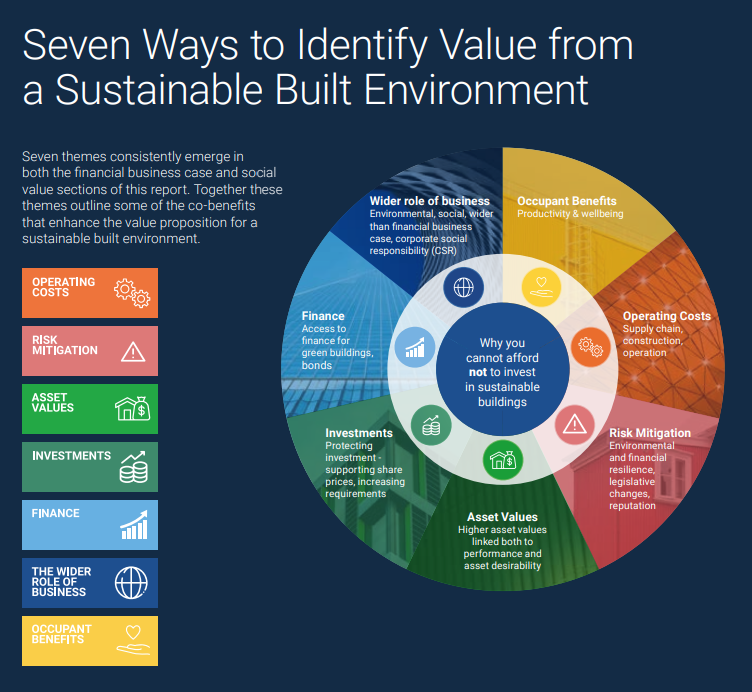The Business Imperatives of Sustainable Buildings

WSP was appointed by the World Green Building Council (WorldGBC) as Consultant for a new flagship report, Beyond the Business Case: Why you can’t afford not to invest in a sustainable built environment. The report was launched at COP26 in Glasgow in November during the day dedicated to Cities, Regions and the Built Environment.
We asked David Symons, WSP UK Director of Sustainability, about what this report means for WSP and our clients.
What’s the background to Beyond the Business Case?
WorldGBC is a global network that works with businesses, organisations and governments to accelerate sustainability and decarbonisation in the building and construction sectors. WORLDGBC produced Beyond the Business Case in the lead up to COP26 to hasten our industry’s sustainability transformation by capitalising on the economic opportunities, addressing risk mitigation and highlighting the social benefits.
What was WSP’s role in helping WorldGBC present the business case for green buildings?
As a leading consultant on the project, we worked with WorldGBC to help shape the report, provide technical input and gather evidence to support the business case by demonstrating how it changes in a high-carbon or low-carbon, healthy or unhealthy world. We served as the critical friend as the report came together.
We led on two key areas. Firstly, we worked with WorldGBC to identify seven key themes emerging throughout the report, which provide the framework to highlight the benefits of investing in a sustainable built environment. The themes are: Operating Costs; Risk Mitigation; Asset Values; Investments; Finance; The Wider Role of Business; and Occupant Benefits.
Then we carried out research and analysis, much of it based on workshops that we led for other stakeholders and industry experts, including leading architects, national green building organisations, engineering firms and manufacturers for the construction industry. We envisaged a wide range of scenarios to gain their views on how these would impact on buildings, and this feedback helped build the value proposition for a sustainable built environment.
We then fed our findings into the seven key themes and from a baseline scenario we calculated to what extent the business cases would change depending on whether the world successfully reduces greenhouse gas emissions in line with the 1.5oC degree trajectory; or whether we end up with the worst-case scenario of 3 oC. This is summarised on P100 of the report here.
Throughout the report we stressed that we’re not just talking about the state-of-the-art city development. From zero carbon offices in London and climate-ready schools in Lagos, to well-ventilated homes in Vancouver and healthy hospitals in Victoria – the case for green, healthy buildings is clear across the world. And it covers not just new buildings, but also retrofit.
What did you discover?
That the business case for sustainable buildings in unequivocal, even in a high carbon, low regulated world. However, there is a lot of subtlety sitting behind the analysis, which is why setting out the seven themes is important. For example, if you’re operating in a very high carbon world, the business cases linked to asset values and investment are weaker, but from a risk perspective the business case is much stronger since buildings must be able to resist the impacts of greater extremes of temperature and weather.
The report also makes the case for social value. What is meant by this?
Social value is the benefit the built environment can bring to people and the community. That means designing places that are productive to work in, keep occupants healthy and support the local community economically, socially and environmentally. In addition, we’re tracking trends which will become more important for the future. These include older populations in more developed economies, increasing loneliness – especially with the pandemic – and year on year growth in neurodiversity. These social considerations and green building techniques apply to all stages of the project lifecycle and its supply chains, from planning and design to construction and throughout its operation.
Going back to the report as a whole, what are the standout aspects for the construction industry?
Firstly, the report provides clarity around the difference of a 1.5oC and 3oC world. Also, in the context of COP26, many countries have made net zero commitments, generally to be achieved by 2050, which gives us much more certainty about the trajectory of net zero for countries, and by definition the building standards that we and our clients will be working on. Even in the last three years, investment in carbon reduction has moved from a nice to have, to a fundamental part of how we approach the built environment.
The other key issue is the need for resilience. Climate action is a two-sided coin. First, we have to get the carbon out of buildings, not only in the way they are used – reducing the impacts of heating and cooling for example, but also in the way they are built. This means reducing the embodied carbon through the reuse of structural elements, selection of low carbon materials such as timber, modular construction, and so on. On the other side of the coin is the absolute necessity of designing buildings that will withstand hotter, wilder, more extreme weather.
What are the key implications of the report, for WSP and for our clients?
As the report’s title states – we can’t afford NOT to invest in a sustainable built environment. There used to be a green premium, relating to the costs of adding green features. Now to deliver a net zero building is embedded in the cost of doing business. If our clients don’t do it, their assets will be worth less. And the timeline that we have for the decarbonisation of buildings is rapidly accelerating. For example, in the UK, consultation is currently underway to raise energy performance requirements for all private rented commercial buildings in 2027, and again in 2030. This is well within the timescale of projects that are starting now, and it would be inconceivable for us to design buildings below those standards making them unlettable by 2027 or 2030.
It’s the responsibility of all of us at WSP to see the future more clearly and advise our clients and design to that future. And we must ensure that all our people have the skills to design to these future climate scenarios.
Finally, the report’s compelling business case not only goes to the heart of our Future Ready thinking, but also endorses the significant investments clients are now making to decarbonise their assets and build in resilience for the future.

